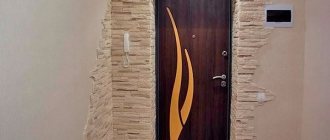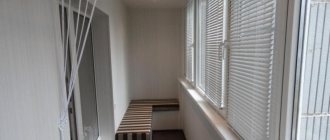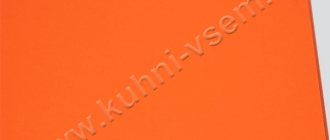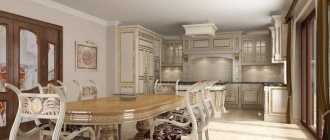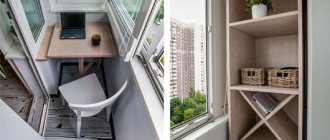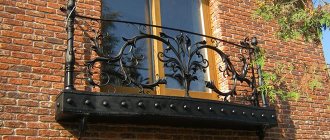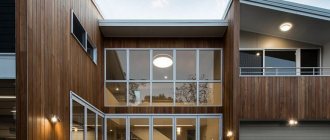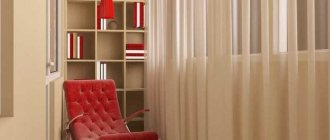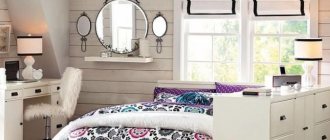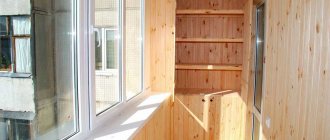Pros and cons of finishing
Unlike natural stone, the basis of artificial stone is cement mortar. The filler is a mixture of concrete, sand or expanded clay, plus binding additives. Such a product has a lower density and, accordingly, weight. What other advantages does this material have?
| pros | Minuses |
| It is durable and has excellent thermal insulation. | The service life of decorative stone is slightly less than that of natural stone. |
| The material is environmentally friendly and hypoallergenic. | Some types of decorative products are not resistant to mechanical stress. |
| Finishing a balcony with decorative stone is easier than laying ceramic tiles, which allows you to do the cladding yourself. | If gypsum is used in production, the surface should be additionally protected from water. |
| It is relatively inexpensive, but is also resistant to temperature changes and mold. |
Decorating ideas and work order
There will be no problems when combining decorative stone with other finishing materials - it goes well with wallpaper, plaster, wood and even plastic. Most often, only part of the surface is decorated with stone, and not the whole. These could be corners or inserts on the wall, a corner with green plants.
Styling corners
You can decorate not only the corners, but also the window and doorway, completely lay out one of the walls, and so on. The resulting finish can resemble a medieval castle, a spectacular natural grotto, or a respectable office - it all depends on what design style you choose for your balcony.
How to veneer walls
Before you begin installing decorative stone on the walls, you need to decide on the type of artificial covering. So, if you have chosen a lightweight material, then you will not need to further strengthen the walls.
Important. If you have chosen a material where the filler is not expanded clay, but sand, then the walls will need to be additionally reinforced with metal mesh before installation.
As for the type of base, decorative stone can be mounted on any type of coating:
- plaster;
- wood;
- foam blocks;
- metal;
- brick;
- concrete.
For alternative methods of finishing balcony walls, see a separate review.
The material does not have high requirements for evenness, but large differences in height, as well as cracks and potholes, must be sealed with plaster. If metal surfaces are being prepared for installation, they must be thoroughly cleaned and then a plaster mesh should be laid on top.
The wood is prepared as follows: the wood should be insulated from moisture, then leveled with a plaster mixture (if necessary), after which a plaster mesh should also be installed.
Advice. All previous cladding must be removed especially carefully. If underneath you find a smooth but porous coating, then you don’t have to putty it, but you must treat it with a primer, which will improve adhesion to the coating.
Decorating one wall with decorative stone
Decorative stone is glued to prepared surfaces, for which cement-sand mortar or special adhesive compositions can be used. It is preferable to use glue - it can be applied either to the back, flat surface of the stone, or directly to the wall - this will not affect the final strength of the coating in any way.
Atypical stone laying in vertical lines
Artificial stone, which is produced in tile format, can be laid using one of 2 technologies:
- Seamless method. All tiles are mounted close to each other so that there are no seams between them.
- With jointing. In this case, a certain distance within 15-25 mm is maintained between the cladding fragments. This is the most common installation method, convenient to implement regardless of what type of tile is chosen. In addition, it allows you to create sealed surfaces.
Types of artificial stone texture
The construction market offers decorative products in the form of individual composite elements or solid sheets with a thickness of 3 to 12 mm. To give an aesthetic appearance, dyes are added to the composition, the quality of which determines the resistance of the material to ultraviolet radiation.
Textures have different designs:
- Imitation of natural stone. Typically untreated marble, granite or quartz with raised shapes, chips and jagged edges.
- Rubble. Imitates large river pebbles or the texture of boulders.
- Under the brick. Panels or individual tiles to imitate brickwork.
- Polished stone. It is a conglomerate (industrial marble with the addition of natural stone chips) or porcelain stoneware.
- Imitation of sandstone and limestone. Sawn stones with a smooth surface.
- Torn stone. Facing tiles with the texture of rough crushed stone.
- Artificial stone textures. Acrylic-based coating in the form of rocks not found in nature.
More and more modern people are choosing the popular loft style for their interior. Its constant feature in the interior decoration of the balcony is decorative brickwork.
The photo shows a closed balcony, the walls of which are tiled in the form of red brick with white grout.
Sometimes decorative tiles can be replaced with environmentally friendly flexible stone. This canvas is made by hand cutting a thin layer of sandstone and applying it to a fiberglass base:
About the painting process
You need to understand that the process of painting a brick wall is not so simple. This is due to the fact that such surfaces are difficult to process. Regardless of the choice of paint, you need to additionally treat the wall surface with a sealant. Applying a sealant is necessary to prevent the paint from coming into contact with dust.
If you want to leave the color of the brick in its natural form, then you need to use special sealants designed to care for brick surfaces.
It is best to paint brick with a brush, this way you can process the seams more efficiently and efficiently. Paint for brick walls, due to its special texture, is able to hide imperfections well - stains, streaks or boundaries between salts will not be noticeable on the surface. But you shouldn't abuse this. It is better to apply the paint immediately and carefully.
All areas adjacent to the surface to be painted, as well as all borders, should be covered with masking tape. Place paper or film under the wall to be treated. This is done so as not to waste time scrubbing the paint off the floor.
Paint is applied to a brick wall in several layers - most often it is two layers. In this case, the second layer is applied only after the first one has completely dried. This process can take from 7 to 9 days.
Related article: Decorating balconies of different sizes: turning the loggia into a cozy corner
In most cases, paint and varnish coatings are applied to already prepared walls, but there are many different situations when you can save on preparatory operations:
- The painting process begins from the corners, where stripes are drawn out with a brush - each width is 2-3 cm.
- The entire surface is painted with a roller or other convenient method. If a mechanical method is chosen for work, then it is necessary to use a compressor that can create a pressure of about 2-3 atm.
- The paint is also applied in two layers - after 10-20 minutes. Brick does not always absorb paint evenly.
- To make the layers of applied coating dry and harden faster, it is recommended to use hardeners. These are inexpensive but very effective means for drying any surface.
The resulting coating will be as reliable as possible; it can be washed with ordinary water and non-aggressive detergents. Acrylic and latex based paints are odorless and will withstand any repair. If a small area of the surface is damaged, it can be repainted - there is no need to paint the entire wall. Over time, the color of this area will merge with the color of the rest of the wall.
On video: how to paint brickwork.
Location of decorative stone on the loggia
Thanks to easy installation, elements of decorative products can be combined with each other and placed on different areas of the balcony.
Walls
Balconies can be open (cold) or closed (can be insulated). On open balconies, the wall adjacent to the house is decorated with stone. On insulated walls, finishing is carried out around the entire perimeter or partially. The larger the cladding area, the lighter it is recommended to choose shades: white, beige, gray.
Slopes
Using slope cladding, you can highlight windows or, conversely, combine them with walls.
Arch between the balcony and the kitchen
If the balcony is combined with a kitchen, a successful design solution would be to combine the rooms with stone cladding. You can decorate the entire doorway or part of it.
Partial finishing
When decorating a balcony, you can use fragments of products, for example, decorate the corners asymmetrically. And horizontal stripes tiled will visually expand the narrow balcony.
The photo shows a spacious balcony decorated with white brick. Thanks to partial cladding, the space does not look overloaded.
Modern Loggia Design Ideas
City dwellers are increasingly choosing natural materials to decorate their apartments, preferring natural motifs to manufacturability. If you decorate your balcony with artificial stone and fill the space with indoor flowers, you can create a real green oasis.
In the photo, an analogue of sandstone and large plants create a tropical corner on the balcony.
In a modern world overloaded with information, minimalism is becoming more and more popular. This direction not least affected interiors. To leave more “air” in the room, adding natural accents, you can use decorative products in a small space.
Joining
This method is used when, during the finishing of painting work, the structure of the brick and masonry seams stand out. For jointing, a copper or steel tube is used - its diameter is at least 1 cm. When the masonry is finished, the mason passes this tube along all the remaining seams - this ensures concave or convex reliefs, removes excess layers of concrete and at the same time preserves the brightness and beauty of the design.
If the design of finishing bricks on a balcony requires highlighting each brick, then the seams between the bricks are painted with a different shade of the selected color. If the loggia consists of silicate or finishing bricks, then there is no need for preliminary preparation for such a surface, however, this is true for latex paints.
Related article: Comfortable bedroom with an attached balcony
Combining artificial stone with other finishing materials
Full stone finishing is rare in modern interiors. Most often it is used in combination with other materials: for example, liquid wallpaper, cork. The most popular way to lighten up stone or brickwork is to paint the walls.
The photo shows a contrasting combination of white gypsum tiles and dark gray paint.
The partner material can be laminate, lining, decorative plaster.
The photo shows a combination of two types of panels: stone and wood.
A combination of tiles and bricks looks advantageous when decorating a balcony.
Characteristics
If you are arranging balconies under stone, strengthen the slab. After all, natural material is quite heavy, and after installation is completed, the load will become several times greater.
Read here! Living room with a balcony - how to combine two interiors? Photo examples of design.
If you choose a material based on strength, then give preference to natural.
Finishing a balcony with stone is easier with the use of an artificial analogue, because it is easier to cut and installed without any problems.
You can do the installation work yourself. This cannot be said about natural material. Only a specialist will be able to perform finishing work efficiently and correctly.
The price of artificial material is correspondingly lower. One square meter ranges from 1000 to 2000 rubles.
So, analog is also an excellent choice. Now you need to choose the right type of material.
Photos of balconies with stone trim
A stylishly decorated balcony can become a dining room, bedroom, relaxation area or even a library.
The photo shows an artificial stone, identical in appearance to natural stone.
When choosing decorative products for finishing a balcony, you should always pay attention to the color scheme of the interior and the material itself. You can play with contrast or, on the contrary, combine similar colors.
The photo shows a balcony that looks respectable thanks to the combination of noble-colored brick and panoramic windows with dark frames.
Choosing paint for a brick wall on the balcony
To paint indoor walls, it is recommended to use environmentally friendly paint solutions.
They usually do not have a pungent odor and do not emit chemical fumes. Modern compositions clean well and do not leave additional streaks.
Loggia design - 45 photos of amazing design options- Balcony in Khrushchev - planning a convenient design for a small balcony (75 photos)
Small loggia - 84 photos of the best ways to arrange it comfortably
For interior work, the following paints are used:
- acrylic;
- latex;
- water-based;
- polymer.
These compounds are well applied to the working surface of a brick wall. To give an intense color, it is recommended to apply several layers.
It is worth noting that after each application, the paint layer must dry well. With repeated application, you can get paint smudges that will ruin the entire appearance.
To add shine, you can add special pigments to the paint, which will shimmer in the sunlight. In the photo of a brick balcony you will note all the subtleties of this work.
How to decorate a balcony with stone yourself?
There are two main finishing methods: with jointing and seamless, in which decorative elements are laid so that there is no space between the joints. This method requires professionalism: it is important that the glue does not leak out of the seam.
Step-by-step instructions for wall cladding
Beginners can also do laying with jointing:
- First, the walls are leveled and cleaned.
- If a pattern is planned on the walls, it is recommended to lay out the tiles on the floor in order to combine them in advance.
- According to the instructions, glue is prepared.
- The glue is applied to the wall using a comb, then onto the decorative material. Products should be laid from top to bottom: cutting is usually done from the floor. Each fragment is glued to the wall using light pressure.
DIY finishing video tutorial
This video tells you more about decorating your balcony yourself:
